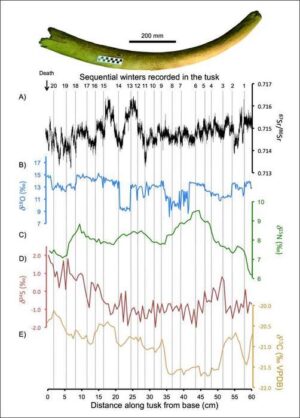
AMERICAN ASSOCIATION FOR THE ADVANCEMENT OF SCIENCE (AAAS)—Ancient DNA and isotopic analyses of a female woolly mammoth tusk dated to be 14,000 years old has helped scientists trace her relatives and migration route, from the western Yukon to her final resting place in an early Alaskan hunter-gatherer settlement. Although there is no direct evidence that humans actively hunted this mammoth, the presence of other mammoth remains in and around the camp site suggest that mammoth herds congregated there, Audrey Rowe and colleagues say – and humans may have chosen the site’s location specifically for that reason. The woolly mammoth (Mammuthus primigenius) is an iconic ice age animal, subject to ongoing debates over the causes of its extinction and recent efforts to “de-extinct” it. The species thrived in steppe tundra across northern Eurasia and Beringia (what is now Russia and Alaska) during the last ice age. Humans are thought to have spread across Beringia between 20 and 12 thousand years ago, overlapping with woolly mammoths for at least 1,000 years. Although humans are known to have used these animals for food and raw materials such as ivory, details about whether they actively hunted the giants, and how humans may have affected the animals’ extinction, remain elusive. Here, Rowe et al.* examined a full woolly mammoth tusk among other mammoth remains found at Swan Point – a 14,000-year-old archaeological site in Tanana Valley, central Alaska, thought to have been used as a seasonal hunting camp by early Alaskans. DNA showed that the mammoth was a young adult female, around 20 years old when she died, and was closely related to other mammoths found at the site. Isotope analyses revealed that she likely spent the beginning of her life in what is now northwestern Canada before migrating about 1,000 kilometers northwestward for around 2.5 years, through the White Mountains and eventually into the camp where her tusk was found.
____________________________

Sequential isotopic analyses along an entire ~60-cm-long transect of a female mammoth tusk from the Swan Point archeological site, interior Alaska. Rowe et al., Sci. Adv. 10, eadk0818 (2024)
____________________________

Artist’s rendering of a mammoth traversing the landscape. Willgard, Pixabay
____________________________
Article Source: AAAS news release.
*A female woolly mammoth’s lifetime movements end in an ancient Alaskan hunter-gatherer camp, Science Advances, 17-Jan-2024. 10.1126/sciadv.adk0818
____________________________
Advertisement

See the incredible archaeology, architecture, and art of northern Spain. A unique tour with special expert guides and lecturers through the collaboration of Popular Archaeology Magazine and Stone & Compass Tours. Not to be missed. Read More About It: https://popular-archaeology.com/article/northern-spains-triple-a-archaeology-architecture-and-art/.
____________________________





